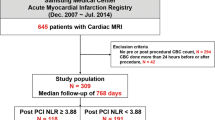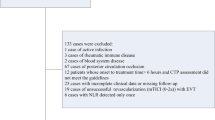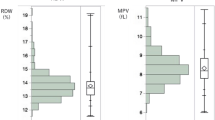Abstract
The evolution of white blood cells after ST elevation myocardial infarction (STEMI) and their association with infarct size and major adverse cardiac events (MACE) remains unclear. Two hundred eleven patients underwent CMR after STEMI. Infarct mass (grams) was determined. Neutrophil, lymphocyte, and monocyte counts (×1,000 cells/ml) were measured upon arrival and at 12, 24, 48, 72, and 96 h. Patients with large infarctions (3rd tertile ≥ 28.5 g vs. 1st and 2nd tertiles < 28.5 g) showed a larger neutrophil count at 12 h (14.8 ± 4.8 vs. 11.4 ± 3.3, p < 0.0001) and an increased monocyte count (maximum at 24 h (0.65[0.50–0.91] vs. 0.55[0.42–0.71], p = 0.004)) but no difference in lymphocyte count. Neutrophil count at 12 h independently predicted large infarctions (OR 1.14, 95%CI [1.04–1.26], p = 0.008). During follow-up (median 504 days), 25 MACE occurred. Neutrophil count at 96 h independently predicted MACE (HR 1.2, 95%CI [1.1–1.4], p = 0.003). Large infarctions show a marked neutrophil peak and an increasing monocyte count. Neutrophil count independently predicts large infarctions and MACE.





Similar content being viewed by others
Abbreviations
- CMR:
-
Cardiovascular magnetic resonance imaging
- STEMI:
-
ST elevation myocardial infarction
- MACE:
-
Major adverse cardiac events
- TIMI:
-
Thrombolysis in myocardial infarction
References
Nunez, J., E. Nunez, J. Sanchis, V. Bodi, and A. Llacer. 2006. Prognostic value of leukocytosis in acute coronary syndromes: The cinderella of the inflammatory markers. Current Medicinal Chemistry 13(18): 2113–2118.
Barron, H.V., C.P. Cannon, S.A. Murphy, E. Braunwald, and C.M. Gibson. 2000. Association between white blood cell count, epicardial blood flow, myocardial perfusion, and clinical outcomes in the setting of acute myocardial infarction: A thrombolysis in myocardial infarction 10 substudy. Circulation 102(19): 2329–2334.
Kirtane, A.J., A. Bui, S.A. Murphy, H.V. Barron, and C.M. Gibson. 2004. Association of peripheral neutrophilia with adverse angiographic outcomes in ST-elevation myocardial infarction. American Journal of Cardiology 93(5): 532–536.
Mariani, M., R. Fetiveau, E. Rossetti, A. Poli, F. Poletti, P. Vandoni, et al. 2006. Significance of total and differential leucocyte count in patients with acute myocardial infarction treated with primary coronary angioplasty. European Heart Journal 27(21): 2511–2515.
Maekawa, Y., T. Anzai, T. Yoshikawa, Y. Asakura, T. Takahashi, S. Ishikawa, et al. 2002. Prognostic significance of peripheral monocytosis after reperfused acute myocardial infarction:a possible role for left ventricular remodeling. Journal of the American College of Cardiology 39(2): 241–246.
Frangogiannis, N.G., C.W. Smith, and M.L. Entman. 2002. The inflammatory response in myocardial infarction. Cardiovascular Research 53(1): 31–47.
Henriques, J.P., F. Zijlstra, A.W. van’t Hof, M.J. de Boer, J.H. Dambrink, M. Gosselink, et al. 2003. Angiographic assessment of reperfusion in acute myocardial infarction by myocardial blush grade. Circulation 107(16): 2115–2119.
Bodi, V., J. Sanchis, M.P. Lopez-Lereu, A. Losada, J. Nunez, M. Pellicer, et al. 2005. Usefulness of a comprehensive cardiovascular magnetic resonance imaging assessment for predicting recovery of left ventricular wall motion in the setting of myocardial stunning. Journal of the American College of Cardiology 46(9): 1747–1752.
Bodi, V., J. Sanchis, M.P. Lopez-Lereu, J. Nunez, L. Mainar, M. Pellicer, et al. 2007. Evolution of 5 cardiovascular magnetic resonance-derived viability indexes after reperfused myocardial infarction. American Heart Journal 153(4): 649–655.
Cerqueira, M.D., N.J. Weissman, V. Dilsizian, A.K. Jacobs, S. Kaul, W.K. Laskey, et al. 2002. Standardized myocardial segmentation and nomenclature for tomographic imaging of the heart: A statement for healthcare professionals from the Cardiac Imaging Committee of the Council on Clinical Cardiology of the American Heart Association. Circulation 105(4): 539–542.
Thygesen, K., J.S. Alpert, and H.D. White. 2007. Universal definition of myocardial infarction. Journal of the American College of Cardiology 50(22): 2173–2195.
Dickstein, K., A. Cohen-Solal, G. Filippatos, J.J. McMurray, P. Ponikowski, P.A. Poole-Wilson, et al. 2008. ESC Guidelines for the diagnosis and treatment of acute and chronic heart failure 2008: The Task Force for the Diagnosis and Treatment of Acute and Chronic Heart Failure 2008 of the European Society of Cardiology. Developed in collaboration with the Heart Failure Association of the ESC (HFA) and endorsed by the European Society of Intensive Care Medicine (ESICM). European Heart Journal 29(19): 2388–2442.
Pennell, D.J., U.P. Sechtem, C.B. Higgins, W.J. Manning, G.M. Pohost, F.E. Rademakers, et al. 2004. Clinical indications for cardiovascular magnetic resonance (CMR): Consensus Panel report. European Heart Journal 25(21): 1940–1965.
Faxon, D.P., R.J. Gibbons, N.A. Chronos, P.A. Gurbel, and F. Sheehan. 2002. The effect of blockade of the CD11/CD18 integrin receptor on infarct size in patients with acute myocardial infarction treated with direct angioplasty: The results of the HALT-MI study. Journal of the American College of Cardiology 40(7): 1199–1204.
Gibson, W.J., and C.M. Gibson. 2006. The association of impaired myocardial perfusion and monocytosis with late recovery of left ventricular function following primary percutaneous coronary intervention. European Heart Journal 27(21): 2487–2488.
Hotchkiss, R.S., C.M. Coopersmith, and I.E. Karl. 2005. Prevention of lymphocyte apoptosis—a potential treatment of sepsis? Clinical Infectious Diseases 41(Suppl 7): S465–S469.
Munford, R.S., and J. Pugin. 2001. Normal responses to injury prevent systemic inflammation and can be immunosuppressive. American Journal of Respiratory and Critical Care Medicine 163(2): 316–321.
Steppich, B.A., P. Moog, C. Matissek, N. Wisniowski, J. Kuhle, N. Joghetaei, et al. 2007. Cytokine profiles and T cell function in acute coronary syndromes. Atherosclerosis 190(2): 443–451.
Bodi, V., J. Sanchis, J. Nunez, E. Rumiza, L. Mainar, M.P. Lopez-Lereu, et al. 2009. Post-reperfusion lymphopenia and microvascular obstruction in ST-segment elevation acute myocardial infarction. Revista Espanola de Cardiologia 62(10): 1109–1117.
Bodi, V., J. Sanchis, J. Nunez, L. Mainar, G. Minana, I. Benet, et al. 2008. Uncontrolled immune response in acute myocardial infarction: Unraveling the thread. American Heart Journal 156(6): 1065–1073.
Acknowledgments
This study was supported by the “Instituto de Salud Carlos III” with FIS PI080128 and Heracles grants and by the Spanish Society of Cardiology with a FEC grant.
Conflict of interest statement
No conflict of interest exists in the present study.
Author information
Authors and Affiliations
Corresponding author
Electronic supplementary material
Below is the link to the electronic supplementary material.
Online Table 1
Cardiac catheterization data of the whole study group and of patients with and without large infarction (DOC 31 kb)
Online Table 2
Cardiac catheterization data of patients with and without major adverse cardiac events (DOC 31 kb)
Rights and permissions
About this article
Cite this article
Husser, O., Bodi, V., Sanchis, J. et al. White Blood Cell Subtypes after STEMI: Temporal Evolution, Association with Cardiovascular Magnetic Resonance—Derived Infarct Size and Impact on Outcome. Inflammation 34, 73–84 (2011). https://doi.org/10.1007/s10753-010-9209-0
Published:
Issue Date:
DOI: https://doi.org/10.1007/s10753-010-9209-0




